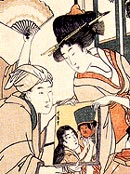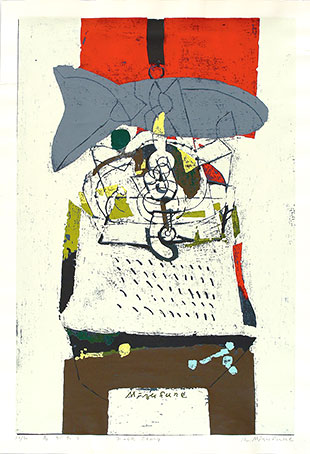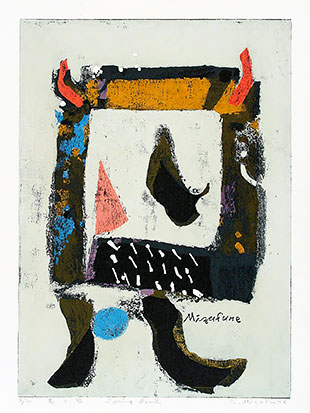

Mizufune Rokushû (水船六州)
|
 Mizufune Rokushû (水船六州 1912-80), born in Kure, Hiroshima, was the son of a calligraphy teacher. He graduated in 1936 from the Tokyo School of Fine Arts (sculpture). Along the way he also studied ancient Chinese calligraphy and attended a printmaking study group taught by Hiratsuka Un'ichi. Later, Mizufune taught art at Kantô Gakuin (関東学院) middle school, Yokohama and after 1953 he became the principal of Kantô Gakuin's elementary school.
Mizufune Rokushû (水船六州 1912-80), born in Kure, Hiroshima, was the son of a calligraphy teacher. He graduated in 1936 from the Tokyo School of Fine Arts (sculpture). Along the way he also studied ancient Chinese calligraphy and attended a printmaking study group taught by Hiratsuka Un'ichi. Later, Mizufune taught art at Kantô Gakuin (関東学院) middle school, Yokohama and after 1953 he became the principal of Kantô Gakuin's elementary school.
Mizufune was a founding member of the Shin Hanga Shûdan (New Print Group) in 1932 (reorganized in 1937 as Zôkei Hanga Kyôkai, Formative Print Association). He is best known in Japan as a sculptor, exhibiting and winning art association regional prizes each year from 1937 to 1940, as well as national government-sponsored prizes in 1947, 1948, and 1950. Attracted to woodcuts when his middle school art teacher gave him a book of the Nowegian artist Edvard Munch's work, Mizufune began exhibiting prints seriously in 1955. He established a further connection with the West when he lived in the U.S. in 1961-62
As for his printmaking technique, Mizufune used thick, opaque watercolor with light colors frequently applied over dark. He achieved this by thickening water-based inks with Chinese white or shell powder, inking and printing color blocks several times and building up layers into an impasto. The result was a pigment texture that looked much like thick oil paint. Moreover, many of his prints reflected aspects of the sculptures he created around the same time.
Helen Merrit further describes Mizufune's process by saying, "He planned his imgery by cutting paper shapes which he then transferred to woodblocks and used as guides for cutting. Using heavy torinoko paper, he usually printed an uncut block in sumi as a first step to create a foundation of black. On this he then built up layers of opaque color. The pigment is ordinary tube watercolor laced with Chinese white. To achieve the strong color and thick texture he made six or seven impressions of each block. Usually he made about three prints [completed impressions] at a time, making more as he needed them. If he felt like it, he modified the color from print to print. He saw no reason for making the prints identical since they were all original works of art. Nor did he see any reason to date his prints, for he felt that a particular point in time was irrelevant to them."
 Oliver Statler (see reference below) quoted Mizufune, as follows: "Each print and sculpture begins in my mind with a poem.... There is aware [pathos, compassion, sensibility: 哀れ] behind each of my prints. It reflects the Buddhist way of thought blended with our native Japanese way. Natural shapes stir me, old and weathered things ... patches of melting snow, pieces of driftwood, rusted iron, fragments of glass ... broken and discarded things, the imperfect, the helpless."
Oliver Statler (see reference below) quoted Mizufune, as follows: "Each print and sculpture begins in my mind with a poem.... There is aware [pathos, compassion, sensibility: 哀れ] behind each of my prints. It reflects the Buddhist way of thought blended with our native Japanese way. Natural shapes stir me, old and weathered things ... patches of melting snow, pieces of driftwood, rusted iron, fragments of glass ... broken and discarded things, the imperfect, the helpless."
The print illustrated above is titled "Folk Story" (Mukashi gatari: 昔がたり), printed in the 1960s or 70s with an edition number of 10/30 and an image size of 680 x 452 mm on paper measuring 736 x 507 mm. The pigments are so abundantly applied that the otherwise fairly stiff paper has buckled slightly from the irregular stresses imposed by the colorants. There are also a few short printing creases mostly in the margins, probably due to the hard pressure required to rub the dense pigments into the paper. Typically, for Mizufune, some of the lighter pigments were applied over darker pigments.
The print illustrated on the left is titled "Spring Devil" (Haru no oni, 春の鬼) with an edition number of 3/30 and an image size of 532 x 382mm on paper measuring 587 x 440 mm. Gaston Petit (see reference below) states that the design was cut in 1964 but printed in 1972 from eight blocks of shina-faced plywood on torinoko paper. The colorants were Holbein watercolors mixed with gofun (shell-powder white, 胡粉). This design surface has slightly less of a sculptural feeling that does "Folk Story" above, but instead relies on what Merritt calls Mizufune's "aesthetic sensibility on the calligraphy he learned in childhood. He modified and stylized kanji, feeling no obligation to retain conventional configurations." Moreover, it can be said here that with "Spring Devil," Mizufune offers up an amusing implementation of the ideograph for "devil" (鬼) by anthropomorphizing the kanji, as it sprouts red horns above a crude square face, with the lower strokes appearing as legs. © 2019 by John Fiorillo
BIBLIOGRAPHY
- Helen Merritt, Modern Japanese Prints: The Early Years. Honolulu: University of Hawai'i Press, 1990, pp. 255-56.
- Gaston Petit, 44 Modern Japanese Print Artists. Tokyo/New York: Kodansha, 1973, no. 150 in vol. 2
- Smith, L.: Modern Japanese Prints, 1912-1989. London: British Museum Press, 1994, pp. 59-60, plate 119 and p. 63.
- Oliver Statler, "Newsletter on Contemporary Japanese Prints," vol. 2, no. 1, Feb. 1972,privately issued by the Helen and Felix Juda Collection, Los Angeles.
Viewing Japanese Prints |